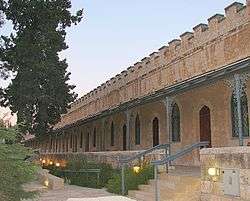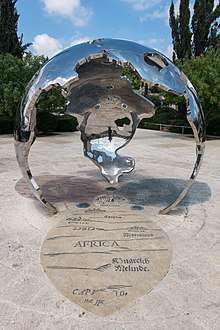Mishkenot Sha'ananim
Mishkenot Sha'ananim (Hebrew: משכנות שאננים, lit. Peaceful Habitation) was the first Jewish neighborhood built outside the walls of the Old City of Jerusalem, on a hill directly across from Mount Zion. Built in 1859–1860, it was the first area of Jewish settlement in Jerusalem outside the Old City walls,[1] and was one of the first structures to be built outside the Old City of Jerusalem, the others being Kerem Avraham, the Schneller Orphanage, Bishop Gobat school and the Russian Compound.[2]


History
Ottoman era
Mishkenot Sha'anim was built by British Jewish banker and philanthropist Sir Moses Montefiore in 1860, having acquired the land from the Governor of Jerusalem, Ahmad Agha Duzdar. [3] It was built as an almshouse, paid for by the estate of an American Jewish businessman from New Orleans, Judah Touro.[4] Since it was outside the walls and open to Bedouin raids, pillage and general banditry rampant in the region at the time, the Jews were reluctant to move in, even though the housing was luxurious compared to the derelict and overcrowded houses in the Old City.[5] As an incentive, people were even paid to live there, and a stone wall was built around the compound with a heavy door that was locked at night.[6] The name of the neighborhood was taken from the Book of Isaiah: "My people will abide in peaceful habitation, in secure dwellings and in quiet resting places" (Isaiah 32:18).[4] It later became part of Yemin Moshe which was established in 1892–1894.
Jordanian era

After the 1948 Arab–Israeli War, when the Old City was captured by the Arab Legion, Mishkenot Sha'ananim bordered on no man's land in proximity to the armistice line with the Kingdom of Jordan, and many residents left in the wake of sniper attacks by Jordanian Arab Legionnaires.[7] Only the poorest inhabitants remained, turning the complex into a slum.
Restoration after 1967
The no-man's-land bordering Mishkenot Sha'ananim was captured by Israel during the 1967 War, together with the rest of Eastern and Old Jerusalem.[8]
In 1973, Mishkenot Sha'ananim was turned into an upscale guesthouse for internationally acclaimed authors, artists and musicians visiting Israel.[4] Apart from guesthouse facilities, it is now a convention center and home of the Jerusalem Music Center.[1] The music center was inaugurated by Pablo Casals shortly before his death.[4]
The Jerusalem Center for Ethics was established in Mishkenot Sha'ananim in 1997. The board of directors is headed by Prof. Yitzhak Zamir, a retired justice of the Israeli Supreme Court.[9]
 Etzioni Flame
Etzioni Flame
 Ha-Takhana
Ha-Takhana Jerusalem als Zentrum der Welt
Jerusalem als Zentrum der Welt
See also
- Yemin Moshe
- Mea Shearim
- Montefiore Windmill
- Statue of Winston Churchill, Mishkenot Sha’ananim
- Mishkenot Shaananim International Writers Festival
- Expansion of Jerusalem in the 19th century
References
- Mishkenot Sha'ananim, jewishvirtuallibrary.org
- Kark, Ruth; Oren-Nordheim, Michal (2001). Jerusalem and Its Environs: Quarters, Neighborhoods, Villages, 1800–1948. Wayne State University Press. pp. 74, table on p.82-86. ISBN 0-8143-2909-8.
The beginning of construction outside the Jerusalem Old City in the mid-19th century was linked to the changing relations between the Ottoman government and the European powers. After the Crimean War, various rights and privileges were extended to non-Muslims who now enjoyed greater tolerance and more security of life and property. All of this directly influenced the expansion of Jerusalem beyond the city walls. From the mid-1850s to the early 1860s, several new buildings rose outside the walls, among them the mission house of the English consul, James Finn, in what came to be known as Abraham's Vineyard (Kerem Avraham), the Protestant school built by Bishop Samuel Gobat on Mount Zion; the Russian Compound; the Mishkenot Sha’ananim houses: and the Schneller Orphanage complex. These complexes were all built by foreigners, with funds from abroad, as semi-autonomous compounds encompassed by walls and with gates that were closed at night. Their appearance was European, and they stood out against the Middle-Eastern-style buildings of Palestine.
- Diaries of Sir Moses and Lady Montefiore : comprising their life and work as recorded in their diaries from 1812 to 1883, Volume 2, pages 51-52: “Ahhmed Agha Dizdar, who had been Governor of Jerusalem during the reign of Mohhammad Ali, and who since the year 1839 had stood in friendly relations with Sir Moses, was the owner of the land in question. When Sir Moses broached the subject of the purchase to him, his answer was: "You are my friend, my brother, the apple of my eye, take possession of it at once. This land I hold as an heirloom from my ancestors. I would not sell it to any person for thousands of pounds, but to you I give it without any money: it is yours, take possession of it." " I myself, my wife, and children, we all are yours." And this was his reply to Sir Moses day after day, whenever he was asked the price for which he would sell the said property. Ultimately, after a whole day's most friendly argument, which almost exhausted all my stock of Arabic phraseology (having acted as interpreter between him and Sir Moses), he said to me: "You are my friend, my brother; by my beard, my head, I declare this is the case. Tell Sir Moses to give me a souvenir of one thousand pounds sterling, and we will go at once to the Ckadee."
- Street People, Helga Dudman, The Jerusalem Post/Carta, 1982, pp. 21–22
- Jerusalem architectural history
- "Archived copy". Archived from the original on 22 December 2009. Retrieved 3 October 2013.CS1 maint: archived copy as title (link) More information about Yemin Moshe
- Menachem Klein, Lives in Common, pg. 128
- "BBC NEWS". news.bbc.co.uk.
- "Konrad Adenauer Conference Center of Mishkenot Sha'ananim". Archived from the original on 21 October 2009.
